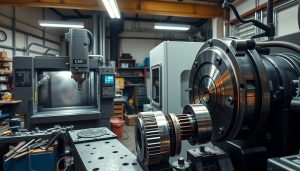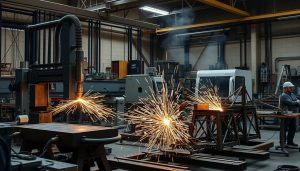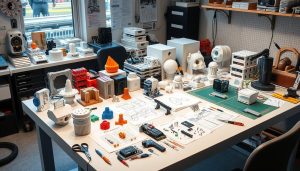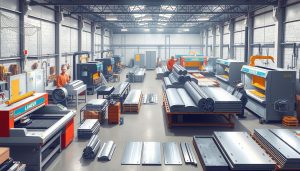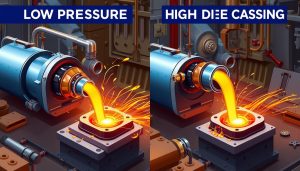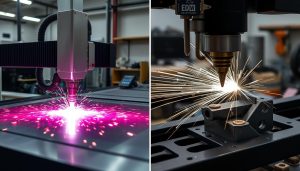In the dynamic world of modern manufacturing, two distinct approaches have emerged as game-changers: subtractive and additive manufacturing. As the demand for innovative products and efficient production methods continues to grow, understanding the nuances between these two manufacturing processes has become increasingly crucial for businesses and consumers alike.
Subtractive manufacturing, often associated with traditional machining techniques like CNC (Computer Numerical Control) milling, involves the removal of material from a solid block or workpiece to create the desired shape or product. Conversely, additive manufacturing, commonly known as 3D printing, builds objects layer by layer, adding material to create the final product.
These contrasting approaches have significant implications for cost, speed, material efficiency, and the types of products that can be produced. By exploring the key differences and applications of subtractive and additive manufacturing, businesses can make informed decisions about the most suitable manufacturing method for their specific needs.
What is Additive Manufacturing?
Additive manufacturing, also known as 3D printing, is a revolutionary technology that has transformed the way we create objects. Unlike traditional subtractive manufacturing processes, where material is removed from a larger block, additive manufacturing builds objects layer by layer, a process known as layer-by-layer fabrication. This innovative approach allows for the creation of complex and intricate designs that would be challenging or even impossible to achieve through conventional methods.
How Additive Manufacturing Works
The additive manufacturing process begins with a digital 3D model, which is then sliced into thin horizontal layers. These layers are then successively printed, often using a variety of materials such as plastic, metal, or even ceramic, to construct the final object. This rapid prototyping technique enables the production of highly customized and personalized products, making it a valuable tool in industries ranging from aerospace to healthcare.
Materials Used in Additive Manufacturing
- Thermoplastic polymers (e.g., ABS, PLA, Nylon)
- Metals (e.g., titanium, stainless steel, aluminum)
- Ceramics
- Composites (e.g., carbon fiber-reinforced polymers)
Advantages of Additive Manufacturing
- Design Flexibility: Additive manufacturing allows for the creation of complex and intricate designs that would be difficult or impossible to achieve using traditional manufacturing methods.
- Reduced Material Waste: Unlike subtractive manufacturing, where material is removed from a larger block, additive manufacturing only uses the material necessary to create the final product, resulting in significantly less waste.
- Rapid Prototyping: The layer-by-layer 3D printing process enables the quick and cost-effective production of prototypes, allowing for faster product development and iteration.
- Customization: Additive manufacturing makes it possible to produce highly customized and personalized products, meeting the specific needs and preferences of individual customers.
“Additive manufacturing has the potential to revolutionize the way we design and produce products, unlocking new possibilities and efficiencies across a wide range of industries.”
What is Subtractive Manufacturing?
Subtractive manufacturing is a widely used industrial process that involves the removal of material from a solid block or workpiece to create the desired shape or part. This approach, often referred to as CNC machining, utilizes a variety of tools and techniques to precisely cut, grind, or mill away the excess material, leaving behind the final product.
How Subtractive Manufacturing Works
The subtractive manufacturing process typically begins with a raw material, such as metal, plastic, or wood, which is then shaped using a range of material removal techniques. These may include milling, turning, drilling, or grinding, depending on the complexity of the part and the required level of precision cutting. Computer Numerical Control (CNC) machines are commonly employed to automate the manufacturing process, ensuring consistent quality and repeatability.
Materials Used in Subtractive Manufacturing
- Metals: Aluminum, steel, titanium, and various alloys
- Plastics: Acrylic, polycarbonate, ABS, and engineering-grade polymers
- Wood: Hardwoods and softwoods
- Composites: Carbon fiber, fiberglass, and other reinforced materials
Advantages of Subtractive Manufacturing
- High Precision: Subtractive manufacturing techniques, such as CNC machining, can achieve exceptional levels of accuracy and surface finish quality.
- Repeatability: The automated nature of CNC machines ensures consistent part production, making subtractive manufacturing ideal for high-volume manufacturing.
- Versatility: A wide range of materials can be processed using subtractive techniques, allowing for the creation of diverse and complex components.
- Cost-effectiveness: For certain applications, subtractive manufacturing can be a more cost-effective solution compared to additive manufacturing, particularly for mass production.
Overall, subtractive manufacturing remains a crucial process in the industrial landscape, offering unparalleled precision, repeatability, and material versatility to meet the evolving demands of various industries.
Key Differences Between Additive and Subtractive Manufacturing
When it comes to manufacturing, the choice between additive and subtractive processes can have a significant impact on cost, production efficiency, and material utilization. Understanding the key differences between these two approaches is essential for making informed decisions that align with your business needs.
Cost Comparison
Additive manufacturing, often referred to as 3D printing, typically involves lower upfront costs for equipment and tooling compared to subtractive manufacturing. However, the cost per part produced can be higher due to the materials and energy consumption required for the additive process. Subtractive manufacturing, on the other hand, may have higher initial costs but can often achieve a lower cost per part, especially for large-scale production.
Speed and Precision
Subtractive manufacturing, such as CNC machining, is generally faster and can achieve higher levels of precision compared to additive manufacturing. The ability to mass-produce parts with consistent quality makes subtractive processes well-suited for high-volume production. Additive manufacturing, on the other hand, can be advantageous for creating complex geometries and customized parts, where the speed of production may be secondary to the design flexibility.
Material Waste and Efficiency
Subtractive manufacturing inherently generates more material waste, as the production process involves removing material from a larger block or sheet. Additive manufacturing, in contrast, is known for its material efficiency, as it only uses the necessary amount of material to build the desired part, reducing waste and scrap.
Suitable Applications for Each Method
- Additive manufacturing is well-suited for prototyping, custom parts, and small-batch production where design flexibility and material efficiency are prioritized.
- Subtractive manufacturing excels in high-volume production, where speed, precision, and cost-effectiveness are crucial, such as in the automotive, aerospace, and industrial machinery industries.
| Characteristic | Additive Manufacturing | Subtractive Manufacturing |
|---|---|---|
| Cost | Lower upfront, higher per-part | Higher upfront, lower per-part |
| Speed | Slower | Faster |
| Precision | Lower | Higher |
| Material Waste | Lower | Higher |
| Suitable Applications | Prototyping, custom parts, small-batch | High-volume production, industrial machinery |

“The choice between additive and subtractive manufacturing is not black and white; it’s about understanding the trade-offs and selecting the approach that best fits your production needs and goals.”
When to Choose Additive Manufacturing?
Additive manufacturing, commonly known as 3D printing, has become a game-changer in the world of manufacturing. Its unique advantages make it the preferred choice in a variety of industries and applications. Let’s explore the best use cases for additive manufacturing and the sectors that have significantly benefited from this innovative technology.
Best Use Cases for Additive Manufacturing
Additive manufacturing excels in applications that require customization, the ability to create complex geometries, and the need for rapid prototyping. This technology is particularly well-suited for producing unique, one-of-a-kind parts, as well as small-batch production runs where traditional manufacturing methods may be less efficient or cost-effective.
- Medical implants and prosthetics: 3D printing enables the creation of personalized, anatomically accurate medical devices tailored to individual patient needs.
- Aerospace and automotive industries: Additive manufacturing allows for the production of lightweight, intricate components that improve performance and efficiency.
- Consumer goods and electronics: 3D printing facilitates the rapid development of customized products, reducing the time-to-market and enabling greater design flexibility.
Industries Benefiting from Additive Manufacturing
The applications of additive manufacturing span a wide range of industries, each leveraging the technology to address unique challenges and drive innovation. Some of the sectors that have significantly benefited from this transformative technology include:
- Healthcare: Additive manufacturing has revolutionized the production of personalized medical devices, prosthetics, and surgical implants.
- Aerospace and Defense: This industry utilizes 3D printing to manufacture lightweight, complex components that improve aircraft performance and reduce production costs.
- Automotive: Additive manufacturing enables the rapid creation of custom parts, prototypes, and tooling, accelerating the design and development process.
- Consumer Goods: 3D printing empowers brands to offer personalized, on-demand products, enhancing the customer experience and reducing inventory challenges.
As the capabilities of additive manufacturing continue to evolve, the range of applications and industries benefiting from this transformative technology will only continue to expand, driving innovation and creating new possibilities.

| Industry | 3D Printing Applications | Advantages |
|---|---|---|
| Healthcare | Personalized prosthetics, implants, and surgical guides | Improved fit, reduced recovery time, and enhanced patient outcomes |
| Aerospace | Lightweight, complex geometries for aircraft components | Increased fuel efficiency, reduced maintenance, and lower production costs |
| Automotive | Custom parts, prototypes, and tooling for vehicle development | Faster time-to-market, design flexibility, and cost savings |
| Consumer Goods | Personalized products and on-demand manufacturing | Enhanced customer experience, reduced inventory, and increased brand loyalty |
When to Choose Subtractive Manufacturing?
While additive manufacturing has gained significant attention in recent years, subtractive manufacturing, or CNC machining, remains a vital part of the manufacturing landscape. Subtractive manufacturing excels in creating high-precision parts and components, making it an ideal choice for a variety of industries and applications.
Best Use Cases for Subtractive Manufacturing
Subtractive manufacturing, particularly CNC machining, is well-suited for producing parts that require tight tolerances, complex geometries, and consistent quality. Some of the best use cases for subtractive manufacturing include:
- Aerospace and defense applications, where high-precision components are critical for safety and performance
- Automotive industry, where subtractive manufacturing is used to create engine parts, transmission components, and other high-precision vehicle parts
- Medical device manufacturing, where strict quality standards and tight tolerances are essential for implants, surgical tools, and other medical equipment
- Industrial machinery, where subtractive manufacturing is used to create gears, bearings, and other critical components
Industries Benefiting from Subtractive Manufacturing
Subtractive manufacturing, particularly CNC machining, is a cornerstone of traditional manufacturing and is widely used across a variety of industries. Some of the industries that benefit most from subtractive manufacturing include:
- Aerospace and Defense
- Automotive
- Medical Devices
- Industrial Machinery
- Robotics and Automation
- Oil and Gas
These industries rely on the precision, repeatability, and versatility of subtractive manufacturing techniques to produce high-quality, CNC machining applications and high-precision parts that are essential to their operations.
| Industry | Subtractive Manufacturing Applications |
|---|---|
| Aerospace and Defense | Aircraft components, rocket parts, satellite structures |
| Automotive | Engine blocks, transmission gears, suspension components |
| Medical Devices | Surgical implants, prosthetic limbs, medical instruments |
| Industrial Machinery | Gears, bearings, machine tool parts |
“Subtractive manufacturing remains a crucial part of the manufacturing landscape, providing unparalleled precision and quality for traditional manufacturing applications.”
Shixinproto: Your Partner for Additive and Subtractive Manufacturing Solutions
At Shixinproto, we pride ourselves on being a comprehensive manufacturing partner that offers both additive and subtractive manufacturing services. Our team of experts is dedicated to helping clients across various industries choose the most appropriate manufacturing method for their specific projects, ensuring optimal results every time.
Whether you’re in need of rapid prototyping, small-scale production, or large-scale manufacturing, Shixinproto has the expertise and capabilities to deliver tailored solutions that meet your unique requirements. Our state-of-the-art facilities are equipped with the latest additive and subtractive technologies, allowing us to produce high-quality parts and components with precision and efficiency.
By leveraging our extensive experience in manufacturing services, prototyping, and production solutions, we work closely with our clients to understand their goals, challenges, and constraints. This collaborative approach enables us to recommend the most suitable manufacturing method, whether it’s additive or subtractive, to achieve the desired outcomes and maximize value for our clients.
